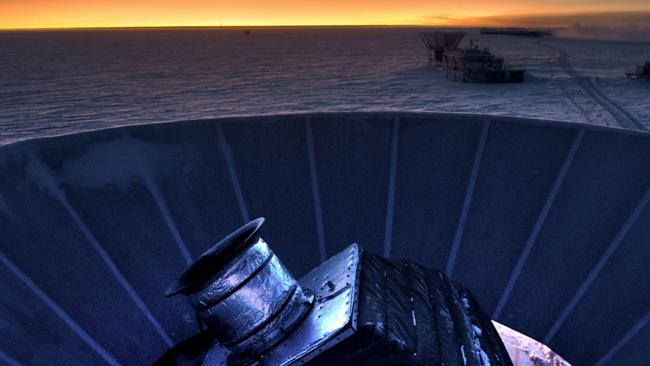BICEP
The first moments after the Big Bang are literally hidden from us: the entire cosmos was too hot and dense for any light to pierce. However, signs of what happened then could be imprinted on the cosmic microwave background (CMB), a cold sea of light filling the modern universe. The BICEP Program is an international collaboration looking for those signs using telescopes at the South Pole. Researchers from the Center for Astrophysics | Harvard & Smithsonian play a leading role in this project, which could provide the first discovery of gravitational waves produced when the universe was just a fraction of a second old.

The BICEP3 telescope is located at the Amundsen-Scott South Pole Station in Antarctica. The metal skirt around the telescope shields it from reflected light from the surrounding ice.
The Telescopes and the Science
The universe today looks pretty much the same on average no matter which direction we look. That sameness is even more dramatic when looking at the CMB: any two points in the CMB have the same temperature to within ten millionths of a degree. To explain that uniformity and a few other mysteries in cosmology, some physicists developed a hypothesis called "inflation." According to this hypothesis, this inflation in the tiny fraction of a second after the Big Bang caused the universe to expand at an extremely fast rate, smoothing out the early irregularities to make the CMB we observe today.
Inflation isn't directly observable by any method we currently have, but the rapid expansion would have produced gravitational waves that permeated the whole universe. These primordial waves have wavelengths too big for existing observatories like LIGO to detect, but they produced a twisting in the light of the CMB known as B-mode polarization. The various instruments of the BICEP project are designed to measure that polarization.
The CMB is mixed with polarized light from astronomical objects closer to home: the gravitational pull of galaxy clusters and dust inside the Milky Way. For that reason, the BICEP telescopes are extremely sensitive, to enable separation of the different components of polarization of light from different sources. The project name was originally an acronym (standing for Background Imaging of Cosmic Extragalactic Polarization), but today only the name BICEP is used.
CfA researchers, particularly the CMB Lab at Harvard, led the effort to design BICEP’s instruments and analyze the data coming from observations. All BICEP Project telescopes are located on top of the Dark Sector Laboratory building just a short distance from the South Pole, as part of the Amundsen-Scott South Pole Station. This location provides dark skies for half the year, as well as extremely dry and relatively cloudless air.
The BICEP Program has operated since 2006, and consists of several stages of operation:
BICEP1 was the first telescope dedicated to looking for B-mode polarization from inflation. This telescope operated from 2006 through 2008, observing the CMB at two wavelengths, using 49 pairs of superconducting detectors known as bolometers. These detectors must be kept at less than a degree above absolute zero; when a CMB photon strikes a bolometer, the device transitions from the superconducting state to a normal material, providing a very sensitive measurement. The pairs of bolometers are oriented at right angles to each other to allow the telescope to measure the polarization of CMB light.
BICEP2 replaced BICEP1 in 2010, and contained significant upgrades. This telescope was built with a 26-centimeter (10 inch) lens and 256 pairs of bolometers viewing at a single wavelength. BICEP2 measured B-mode CMB polarization for the first time, though most of the observed signal came from dust in the Milky Way. The instrument operated until 2012.
The Keck Array is basically five copies of BICEP2 mounted together to point at the same patch of sky. These telescopes operate at two wavelengths and together have 1280 pairs of bolometers, to provide a more detailed view of the CMB sky. The Keck Array began operations in 2011.
BICEP3 was the upgrade to BICEP2, which began operations in 2016. This instrument was designed to be complementary to the Keck Array, with 1280 pairs of bolometers and a 68 cm (27 inch) telescope.
The BICEP Array is the replacement for both the Keck Array, with four BICEP3-size telescopes mounted together. This array observes the CMB using over 30,000 bolometers viewing in five wavelengths. With this increased observational power and the lessons learned from BICEP2, the BICEP Array is designed to pick out the tiny traces of CMB polarization due to inflation. Phased deployment of the array began in the 2019-20 austral summer season at the South Pole.
All data and published papers from the BICEP collaboration are freely available through the project website.